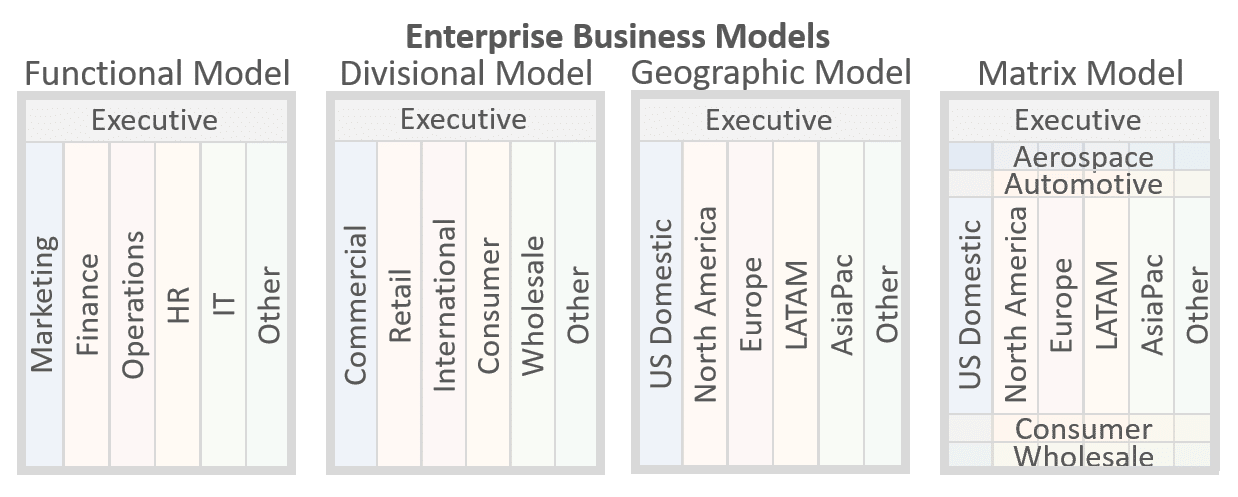The first of three (1 of 3) perspectives used to Organize Enterprise Content segments transformation scope from a Business Perspective. Of course, this perspective is most familiar to participants who work within the entities that a transformation initiative affects.
However, participants from the other perspectives - Technology and Delivery - also need to understand this perspective. Doing so helps align their efforts with those of their business counterparts.
This page introduces the following terms:
- Organizational Structure & Business Segments
- Value Stream
- Process Group
- Business Process
ITM Business Perspectives
Organizational Structures & Business Segments
To begin with, an Organizational Structure refers to an enterprise's highest-level configuration. Every business uses some type of structure. A company's structure may follow one or more of these examples:
- Business Function - such as Sales, Finance, HR.
- Operating Division - such as Retail, Wholesale, Commercial.
- Product Lines - such as Energy, Transportation, Aviation.
- Customer Segments - such as Urgent Care, Inpatient Care, Outpatient Services.
- Geographic Division - such as North America, Europe, AsiaPac.
- Matrix Model - some combination of the above.
Each structural group segments how the firm is led and managed.

In addition, Business Segments occur at various levels within the Organizational Structure. Typically, each represents some sub-section(s) of the overall organization. Frequently, these segments represent an intersection of two or more aspects of the organization. For example, a business function with a particular focus, such as 'Retail Sales - Housewares'. Or, within a geographic area, such as 'Finance - North America'. Moreover, any Business Segment may include other, smaller, segments.
Again, each segment further affects how the firm is led and managed. In general, Business Segments establish the highest levels of ownership and responsibility for the execution of business actions. Of course, this includes actions which relate to Transformative change. Accordingly, their leadership sponsors and funds objectives relating to Solution Definition and Solution Delivery. Segments also offer a succinct means to identify portions of the overall organization which change will affect.

Value Streams
Value Streams represent a series of actions an organization executes to provide a Consumer with an ongoing flow of value. In this case, Consumers are those who receive value which the Value Stream generates. Indeed, a Consumer may be:
- External to the enterprise - such as a Customer, Partner or Supplier; or
- Internal to the enterprise - such as an Employee, Manager or Business Unit.
Value Streams help overcome challenges inherent in the functional silos most firms use. For example, they can help address:
- Impediments to value delivery due to hand-offs and delays.
- Instilling a Consumer-centric perspective across organizational boundaries; and
- Systems designed to address desires of discrete work groups at the expense of broader value delivery.
In fact, many companies have begun to view two separate, interdependent Value Stream types:
- Operational Value Streams - which contain the actions and resources that deliver end-Consumer value using Solutions produced by Development Value Streams; and
- Development Value Streams - which contain the actions and resources that develop Solutions used by Operational Value Streams.
Process Groups
A Process Group describes a series of actions within a Value Stream.
In fact, each Process Group is a set of one or more Business Processes which support a given Business Segment. To clarify, consider a large company that has Sales functions in Europe and Asia. Further, assume each segment defines and executes its own processes. Because there are two distinct Business Segments, there are two, distinct Process Groups. In this case, the set of processes used by Europe would belong to one Process Group. A second set of processes used by Asia belongs to another Process Group.
One, and only one, segment within the Business Structure owns a given Process Group. To put it differently, some segment within an Organization's Structure - a Function, or Division, for example - defines and executes the actions within a given Process Group.
The Business Segment responsible for the Process Group is also responsible for each Business Process within the group. Typically, some lower level organization within the segment, such as a Department within a Division, owns each Process.

Business Processes
All business operations rely upon Processes. A Process is a mid-level description of actions which provide some increment of value.
On one hand, Processes are "mid-level" in that they roll up to Process Groups. Any given Process will roll up to one, and only one, Process Group.
This can seem confusing when a process like "Sales" seems able to roll up to multiple portions of the enterprise. The nuance to understand is the "Sales" process which supports a business segment such as North America, and the "Sales" process which supports an AsiaPac segment may not actually be the same, single "Sales" process.
In this example there are two distinct processes, something like - "Sales - North America" and "Sales - AsiaPac". Each of these Processes may roll up to a single Process Group (e.g., Global Sales) if the company is organized by Function. Alternatively, they may roll up to separate Process Groups (e.g., Retail Sales and Commercial Sales) in a company organized by Division. If there is ever an attempt to make a single Business Process belong to multiple Process Groups, something is amiss.
On the other hand, Processes are "mid-level" in that they also decompose into Activities, Tasks and Steps. The section on Business Process Definitions describes these actions in greater detail.
Finally, each Business Process is supported by a Solution. More on Solutions after viewing the Technology Perspective.
